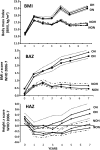Obesity is positively associated with dehydroepiandrosterone sulfate concentrations at 7 y in Chilean children of normal birth weight
- PMID: 23283497
- PMCID: PMC3545681
- DOI: 10.3945/ajcn.112.037325
Obesity is positively associated with dehydroepiandrosterone sulfate concentrations at 7 y in Chilean children of normal birth weight
Abstract
Background: In low-birth-weight girls, obesity increases the risk of premature adrenarche and metabolic complications. However, the consistency of this association in normal-birth-weight children and its potential mediators remain unknown.
Objectives: The objectives were to assess the associations between obesity indicators and dehydroepiandrosterone sulfate (DHEAS) at 7 y of age and to evaluate the role of hormonal markers on these associations.
Design: We assessed in 969 participants (6.9 y; 48% girls; all Tanner I) in the Growth and Obesity Chilean Cohort Study the associations between DHEAS and weight, BMI, waist circumference (WC), waist-to-height ratio, skinfold thickness, and percentage total fat (bioimpedance) and determined whether these associations were related to insulin, insulin-like growth factor I (IGF-I), and leptin. We also compared BMI and height growth from 0 to 7 y of age in nonobese and obese children with normal and high DHEAS (≥75th percentile) at 7 y.
Results: DHEAS concentrations were similar between girls (30.3 ±1.86 μg/dL) and boys (29.4 ±1.73 μg/dL) (P > 0.05); 17.3% of children were obese (BMI-for-age z score ≥2 SD). Adiposity indicators were positively and similarly associated with DHEAS [ie, BMI, β standardized regression coefficient: 0.23 (95% CI: 0.17, 0.29); WC, β standardized regression coefficient: 0.23 (95% CI: 0.16, 0.30)]; these associations were only partially related to IGF-I and leptin. Obese children had twice the risk of high DHEAS (OR: 2.16; 95% CI: 1.51, 3.09); at 7 y, obese children with high DHEAS were fatter and more centrally obese than their counterparts (P < 0.05), although their previous growth was similar (P > 0.05). None of the results differed by sex (P > 0.05).
Conclusion: In children of normal birth weight, obesity is positively associated with DHEAS at 7 y of age.
Figures


Similar articles
-
Early BMI Gain and Later Height Growth Predicts Higher DHEAS Concentrations in 7-Year-Old Chilean Children.Horm Res Paediatr. 2017;87(1):15-22. doi: 10.1159/000452885. Epub 2016 Dec 15. Horm Res Paediatr. 2017. PMID: 27974716 Clinical Trial.
-
High DHEAS in girls and metabolic features throughout pubertal maturation.Clin Endocrinol (Oxf). 2022 Mar;96(3):419-427. doi: 10.1111/cen.14654. Epub 2021 Dec 14. Clin Endocrinol (Oxf). 2022. PMID: 34904249
-
Associations of Dehydroepiandrosterone Sulfate With Cardiometabolic Risk Factors in Prepubertal Children.J Clin Endocrinol Metab. 2018 Jul 1;103(7):2592-2600. doi: 10.1210/jc.2018-00184. J Clin Endocrinol Metab. 2018. PMID: 29757399
-
Offspring body size and metabolic profile - effects of lifestyle intervention in obese pregnant women.Dan Med J. 2014 Jul;61(7):B4893. Dan Med J. 2014. PMID: 25123127 Review.
-
Premature adrenarche: novel lessons from early onset androgen excess.Eur J Endocrinol. 2011 Aug;165(2):189-207. doi: 10.1530/EJE-11-0223. Epub 2011 May 26. Eur J Endocrinol. 2011. PMID: 21622478 Review.
Cited by
-
Novel loci and Mapuche genetic ancestry are associated with pubertal growth traits in Chilean boys.Hum Genet. 2021 Dec;140(12):1651-1661. doi: 10.1007/s00439-021-02290-3. Epub 2021 May 28. Hum Genet. 2021. PMID: 34047840 Free PMC article.
-
Higher body fat and lower fat-free mass in girls with premature adrenarche.J Clin Res Pediatr Endocrinol. 2015 Mar;7(1):45-8. doi: 10.4274/jcrpe.1525. J Clin Res Pediatr Endocrinol. 2015. PMID: 25800475 Free PMC article.
-
The Association of Accelerated Early Growth, Timing of Puberty, and Metabolic Consequences in Children.J Clin Endocrinol Metab. 2023 Aug 18;108(9):e663-e670. doi: 10.1210/clinem/dgad202. J Clin Endocrinol Metab. 2023. PMID: 37029976 Free PMC article. Review.
-
Growth and adrenarche: findings from the CATS observational study.Arch Dis Child. 2021 Oct;106(10):967-974. doi: 10.1136/archdischild-2020-319341. Epub 2021 Apr 30. Arch Dis Child. 2021. PMID: 33931399 Free PMC article.
-
Dairy intake in relation to breast and pubertal development in Chilean girls.Am J Clin Nutr. 2017 May;105(5):1166-1175. doi: 10.3945/ajcn.116.150359. Epub 2017 Apr 5. Am J Clin Nutr. 2017. PMID: 28381475 Free PMC article.
References
-
- Havelock JC, Auchus RJ, Rainey WE. The rise in adrenal androgen biosynthesis: adrenarche. Semin Reprod Med 2004;22:337–47 - PubMed
-
- Kelnar CJ, Brook CG. A mixed longitudinal study of adrenal steroid excretion in childhood and the mechanism of adrenarche. Clin Endocrinol (Oxf) 1983;19:117–29 - PubMed
-
- Palmert MR, Hayden DL, Mansfield MJ, Crigler JF, Jr, Crowley WF, Jr, Chandler DW, Boepple PA. The longitudinal study of adrenal maturation during gonadal suppression: evidence that adrenarche is a gradual process. J Clin Endocrinol Metab 2001;86:4536–42 - PubMed
-
- Remer T, Boye KR, Hartmann MF, Wudy SA. Urinary markers of adrenarche: reference values in healthy subjects, aged 3-18 years. J Clin Endocrinol Metab 2005;90:2015–21 - PubMed
-
- Ibáñez L, Dimartino-Nardi J, Potau N, Saenger P. Premature adrenarche—normal variant or forerunner of adult disease? Endocr Rev 2000;21:671–96 - PubMed
Publication types
MeSH terms
Substances
Grants and funding
LinkOut - more resources
Full Text Sources
Other Literature Sources
Medical

